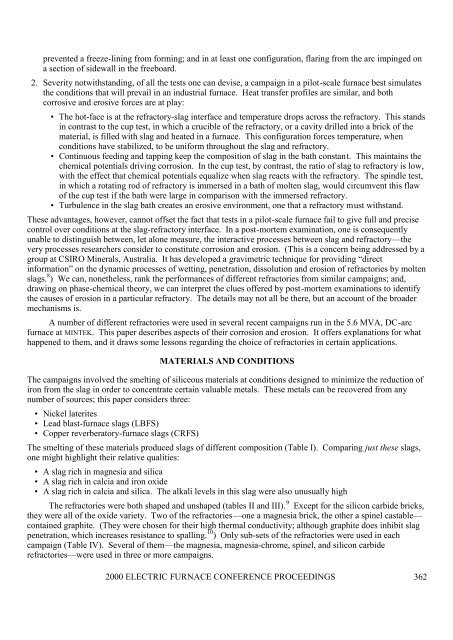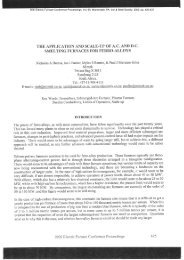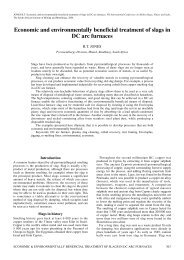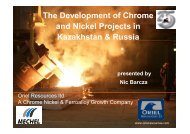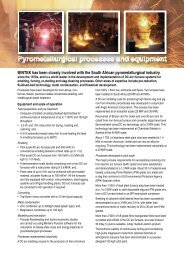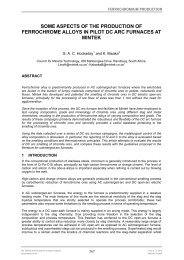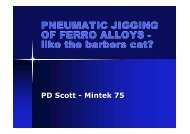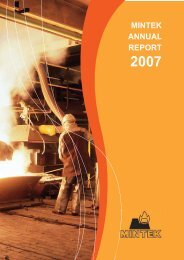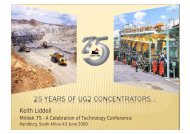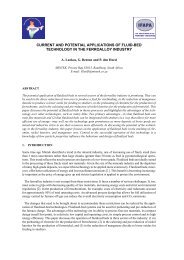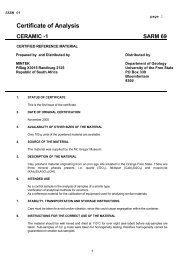Furnace refractory erosion - Mintek
Furnace refractory erosion - Mintek
Furnace refractory erosion - Mintek
Create successful ePaper yourself
Turn your PDF publications into a flip-book with our unique Google optimized e-Paper software.
prevented a freeze-lining from forming; and in at least one configuration, flaring from the arc impinged ona section of sidewall in the freeboard.2. Severity notwithstanding, of all the tests one can devise, a campaign in a pilot-scale furnace best simulatesthe conditions that will prevail in an industrial furnace. Heat transfer profiles are similar, and bothcorrosive and erosive forces are at play:• The hot-face is at the <strong>refractory</strong>-slag interface and temperature drops across the <strong>refractory</strong>. This standsin contrast to the cup test, in which a crucible of the <strong>refractory</strong>, or a cavity drilled into a brick of thematerial, is filled with slag and heated in a furnace. This configuration forces temperature, whenconditions have stabilized, to be uniform throughout the slag and <strong>refractory</strong>.• Continuous feeding and tapping keep the composition of slag in the bath constant. This maintains thechemical potentials driving corrosion. In the cup test, by contrast, the ratio of slag to <strong>refractory</strong> is low,with the effect that chemical potentials equalize when slag reacts with the <strong>refractory</strong>. The spindle test,in which a rotating rod of <strong>refractory</strong> is immersed in a bath of molten slag, would circumvent this flawof the cup test if the bath were large in comparison with the immersed <strong>refractory</strong>.• Turbulence in the slag bath creates an erosive environment, one that a <strong>refractory</strong> must withstand.These advantages, however, cannot offset the fact that tests in a pilot-scale furnace fail to give full and precisecontrol over conditions at the slag-<strong>refractory</strong> interface. In a post-mortem examination, one is consequentlyunable to distinguish between, let alone measure, the interactive processes between slag and <strong>refractory</strong>—thevery processes researchers consider to constitute corrosion and <strong>erosion</strong>. (This is a concern being addressed by agroup at CSIRO Minerals, Australia. It has developed a gravimetric technique for providing “directinformation” on the dynamic processes of wetting, penetration, dissolution and <strong>erosion</strong> of refractories by moltenslags. 8 ) We can, nonetheless, rank the performances of different refractories from similar campaigns; and,drawing on phase-chemical theory, we can interpret the clues offered by post-mortem examinations to identifythe causes of <strong>erosion</strong> in a particular <strong>refractory</strong>. The details may not all be there, but an account of the broadermechanisms is.A number of different refractories were used in several recent campaigns run in the 5.6 MVA, DC-arcfurnace at MINTEK. This paper describes aspects of their corrosion and <strong>erosion</strong>. It offers explanations for whathappened to them, and it draws some lessons regarding the choice of refractories in certain applications.MATERIALS AND CONDITIONSThe campaigns involved the smelting of siliceous materials at conditions designed to minimize the reduction ofiron from the slag in order to concentrate certain valuable metals. These metals can be recovered from anynumber of sources; this paper considers three:• Nickel laterites• Lead blast-furnace slags (LBFS)• Copper reverberatory-furnace slags (CRFS)The smelting of these materials produced slags of different composition (Table I). Comparing just these slags,one might highlight their relative qualities:• A slag rich in magnesia and silica• A slag rich in calcia and iron oxide• A slag rich in calcia and silica. The alkali levels in this slag were also unusually highThe refractories were both shaped and unshaped (tables II and III). 9 Except for the silicon carbide bricks,they were all of the oxide variety. Two of the refractories—one a magnesia brick, the other a spinel castable—contained graphite. (They were chosen for their high thermal conductivity; although graphite does inhibit slagpenetration, which increases resistance to spalling. 10 ) Only sub-sets of the refractories were used in eachcampaign (Table IV). Several of them—the magnesia, magnesia-chrome, spinel, and silicon carbiderefractories—were used in three or more campaigns.2000 ELECTRIC FURNACE CONFERENCE PROCEEDINGS 362


